Day 3 of a three day Early Autumn Tour today, our last day. After a cloudy start, it brightened up nicely, although there was a rather fresh wind which picked up during the morning. We planned to spend the first part of the day down in the Brecks, and then head back up to North Norfolk for the afternoon.
As we made our way south, a Red Kite flapped alongside us, over the field next to the road, a nice addition to the list.
When we got into the heart of the Brecks, we stopped to look for Stone Curlews. After the summer they gather together in large post-breeding flocks, which can be an impressive sight. The first field we tried is a regular site for them at this time of year and we immediately found ourselves looking at a sizeable flock.

The Stone Curlews were gathered on the edge of the field, in the lee of a hedge, sheltered from the wind. The more we scanned up and down, the more we could see. We counted 46 Stone Curlews here, but we couldn’t see some birds which were hunkered down in a dip in the field. Someone else had counted 60 here a short while earlier.
When a lorry thundered past on the road, it spooked the birds and most of flock flew out into the middle of the field. We could really appreciate the numbers now. Most of the Stone Curlews ran quickly back to the edge, but some settled down out on the bare ground, where they disappeared. They are very well camouflaged!
Carrying on a little further along the road, we stopped at another field. At first it looked empty. But as we scanned carefully, we found more Stone Curlews hiding in the low vegetation on a patch of rough ground. Each time we scanned across, we spotted more – there were at least another 23 Stone Curlews here. The birds were a bit closer here and we had some great views of them in the scope.
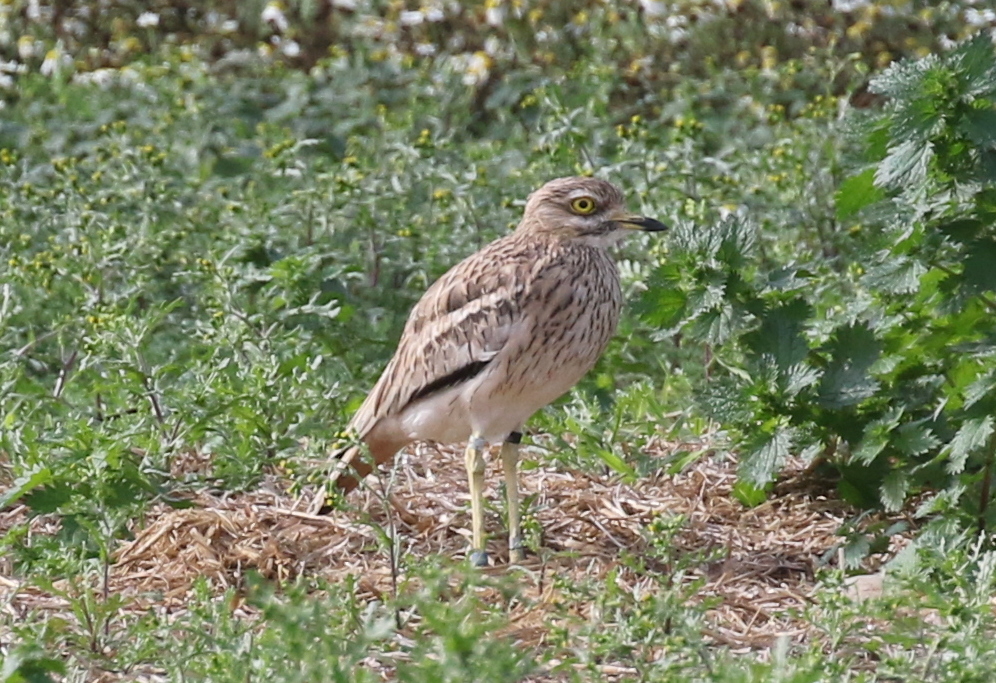
We drove on to another spot overlooking a large pig field. There were lots of Lesser Black-backed Gulls and hundreds of corvids, Rooks, Jackdaws and Carrion Crows, in amongst the pigs. We checked along the margins of the field opposite, where we found some Red-legged Partridges, another new bird for the weekend’s list.
The cloud had started to break now, and we could feel the warmth of the sun. The breeze was strengthening too, good conditions for raptors. We thought we would try our luck, so we drove to a spot of high ground overlooking the forest. There were several Common Buzzards in the air already, hanging in the breeze. A Mistle Thrush flew across and landed in top of trees.
We didn’t have to wait long before a Goshawk appeared. It was a juvenile, brown above and orangey-buff below as it turned in the sunlight. A Kestrel appeared next to it, tiny by comparison, and proceeded to mob it, and the Goshawk responded by having a go back. The two of them circled up, periodically swooping at each other. They seemed to be doing it just for fun, enjoying the wind.
For several minutes, the Goshawk and the Kestrel circled up, gaining height. Finally, the Kestrel decided it had had enough and drifted away. The Goshawk closed its wings and dropped vertically out of the sky, straight down into the trees below. It had certainly been a great start to the day, down in Brecks.
We headed back up to North Norfolk for the rest of the day. Titchwell was already busy when we arrived, and the car parks were pretty full. We found a space in the overflow car park but with all the disturbance now the bushes and brambles here were quiet. As we walked along the path towards the visitor centre, we could hear a tit flock in the sallows. We stopped for a minute and could see Long-tailed Tits flitting around and a Goldcrest with them.
A quick look at the feeders by the visitor centre produced a good selection of finches – several Greenfinches, as well as Goldfinches and Chaffinches. A Dunnock was hopping around on the ground below. We still had some time before lunch, so we decided to head out along Fen Trail. We met the tit flock again in the sallows this side, and a Chiffchaff was calling right above us. As we passed Fen Hide, we looked up to see a Red Underwing, a large moth resting on the side wall, well camouflaged against the wooden boards.
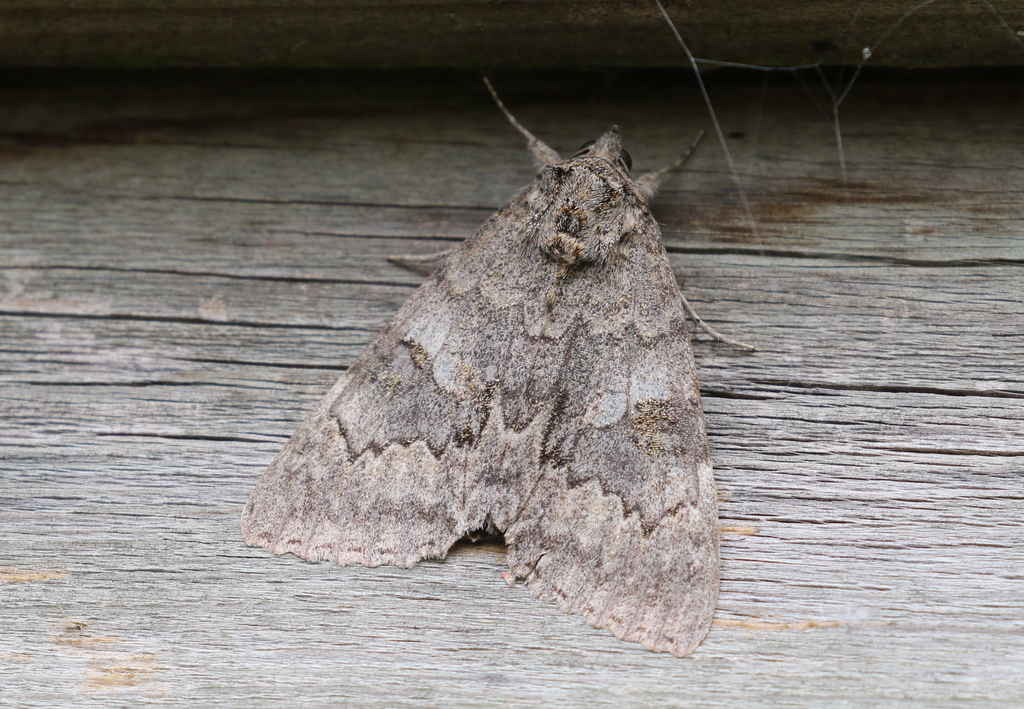
Round at Patsy’s reedbed, we immediately spotted the two Red-crested Pochards busy upending in front of the screen. They are both females, pale-cheeked, dark-capped and with a pale-tipped dark bill. There were also a few Common Pochards too, in with the commoner dabbling ducks – lots of Gadwall, a few Shoveler, Teal and Wigeon.
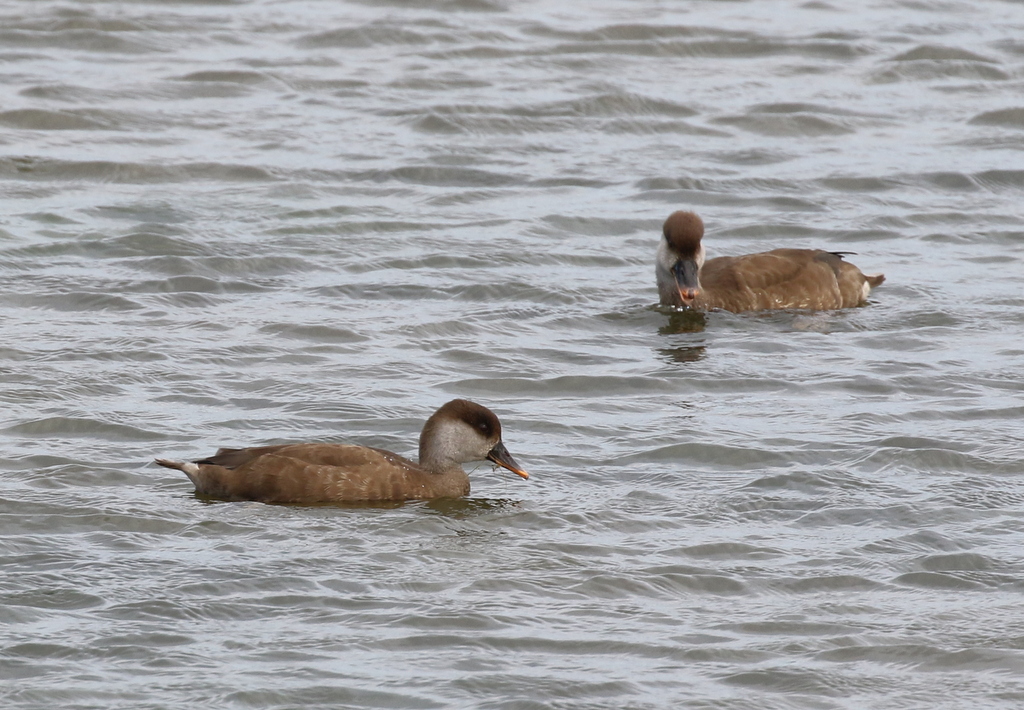
As we stood and scanned across the reedbeds, we saw several Swallows flying past, heading west. They are on their way now, heading off to Africa for the winter, autumn migration in action.
The Autumn Trail is open at this time of year, so we carried on round towards the far corner of the Freshmarsh. There were lots of Common Darter dragonflies along the path, basking down on the gravel, which flew up ahead of us. A Bloody-nosed Beetle was slowly crossing the path as well.

At the end of Autumn Trail we could see several larger white shapes in with the roosting gulls out on the Freshmarsh. They were five Spoonbills, doing what they like to do best, and mostly asleep. It was high tide, so they had come in from the saltmarsh channels to roost. We have been spoilt for Spoonbills this weekend, so they weren’t quite the attraction now compared to the earlier ones we had seen!
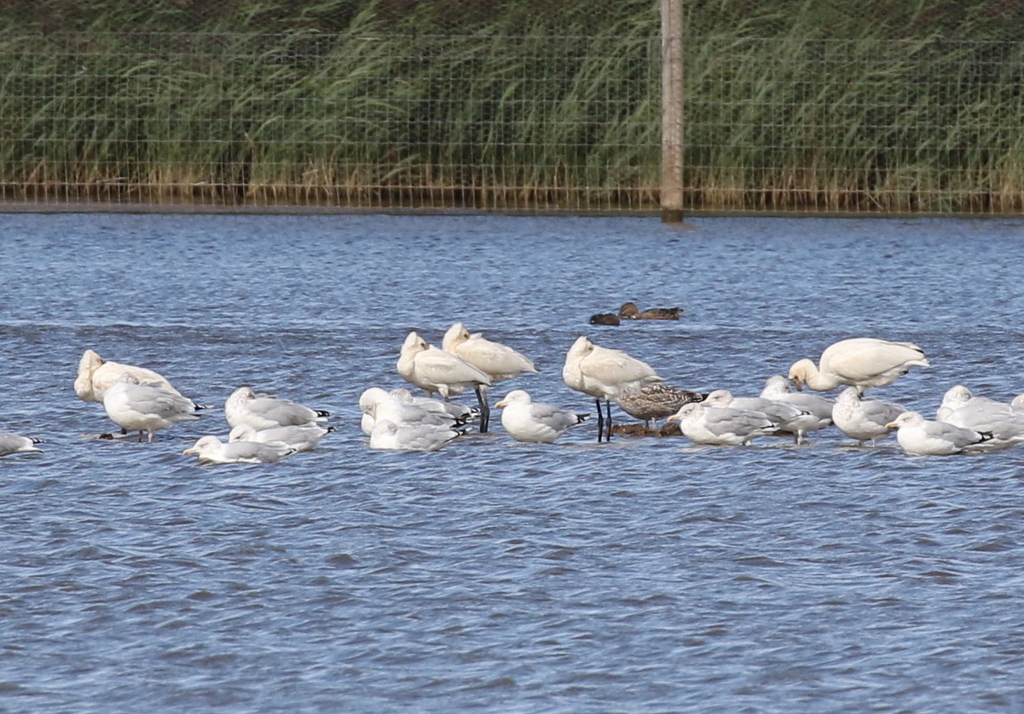
A Common Snipe was busy feeding down on the edge of the reeds and a single Ruff was out on the open mud in front. We could hear Bearded Tits calling in the reedbed but they were unsurprisingly keeping tucked down in the now very brisk breeze. However, as we headed back for lunch, one flew up from the other side of the bank and across the path behind us, disappearing straight out over the reedbed.
After lunch, we headed out along the main path onto the reserve. The reedbed pool was quiet today. We heard another Bearded Tit calling from somewhere down in the reeds. We continued on to Island Hide and started to scan the Freshmarsh. It didn’t take too long to pick up the Curlew Sandpiper. It was a juvenile, scaly-backed and white bellied with a pale orangey wash on the breast. It was with a couple of streaky-bellied juvenile Dunlin, so we had a nice side-by-side comparison in the scope.
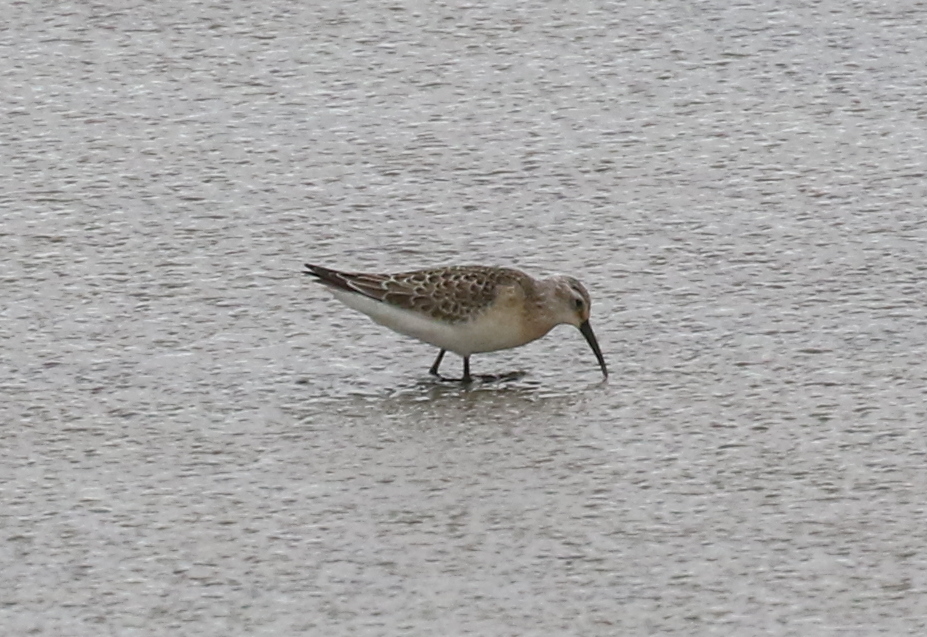
There are still good numbers of Ruff on the reserve, but they are all in either non-breeding or juvenile plumage now. A large flock of godwits was roosting around the islands. Through the scope, we could see they were mostly Black-tailed Godwits, but with a smaller number of Bar-tailed Godwits in with them too. Some of the Bar-tailed Godwits still had the remnants of their rusty breeding plumage.
We could see several Golden Plovers too, hiding in amongst the vegetation on the islands. Some of them were also still sporting some black on the belly left over from their summer plumage. Three or four Ringed Plovers were running around on the mud and we could see a few Avocets scattered around the water still too.
The smaller waders were very jumpy in the wind and kept flying round and landing again. It was hard to keep tabs on where the Curlew Sandpiper was. The presence of several raptors didn’t help either – one or two Marsh Harriers over the reedbed and a brief Hobby over the seawall at the back of the Freshmarsh.
Continuing on out along the main path towards the beach, we stopped to watch a Ruff in down in the far corner of the Freshmarsh, just below path. We could see its loose feathers ruffled in the swirling wind.

The Volunteer Marsh looked quite quiet as we walked past, but there were more waders in the channel at the far end. The tide was going out now and lots of Redshanks and Black-tailed Godwits and a couple of Curlews were busy feeding on the wet mud. One Grey Plover was hiding down in the channel right at the back. We had better views of a nice close Black-tailed Godwit just below the path. We noted its plain grey-brown upperparts, in non-breeding plumage now.

The ‘Tidal Pools’ are not tidal any more and are now very full of water again after the recent very high tides. Just a small area of island is still exposed. The Oystercatchers were roosting on here, in the vegetation, and we could see several Grey Plover and Knot, and a single Turnstone here too. One particularly smart Grey Plover emerged from the vegetation – its was still pretty much in breeding plumage, with black face and belly and bright white brow and breast sides. It has presumably only just returned and will start to moult very soon.
Out at the beach, the tide was still going out. We could see a large flock of godwits down on the shore, waiting for the mussel beds to emerge from the sea. The sea was quite choppy but as we scanned across, we spotted a smart Red-throated Diver on the water, not too far out. It was still in breeding plumage and as it turned into the sun, we could see its red throat. There were several Great Crested Grebes out on the sea too and we managed to find a single drake Common Scoter but it was tricky to see in the swell.
Several Sandwich Terns were flying back and forth and having just remarked that there should be an Arctic Skua out here, one flew in. It landed on the water, then took off again and started chasing after a Sandwich Tern, the two of them twisting and turning in front of the wind farm. We couldn’t see if the Arctic Skua was successful in getting the tern to surrender its last catch, but the skua dropped down again onto the sea. One or two Gannets passed by offshore too.
On our way back, we stopped in at Parrinder Hide. There were several Pied Wagtails and Meadow Pipits in the vegetation on the islands and a flock of Linnets dropped in for a drink. A scan round the margins located a Common Snipe, feeding just inside the fence on Avocet Island. We couldn’t find any other different waders from here today though. A Chinese Water Deer was chomping on the reeds in the edge of the reedbed opposite.
We had not seen or heard so many Pink-footed Geese moving today, until late on in the afternoon. We looked across towards Brancaster and could see several large skeins flying over, heading inland. Presumably they were just returned from Iceland for the winter, on their way to Snettisham and cutting the corner off rather than following the coast. A small group came our way, flying in low over the Freshmarsh, where it looked like they might drop in. But they continued on over our heads and away to the west.
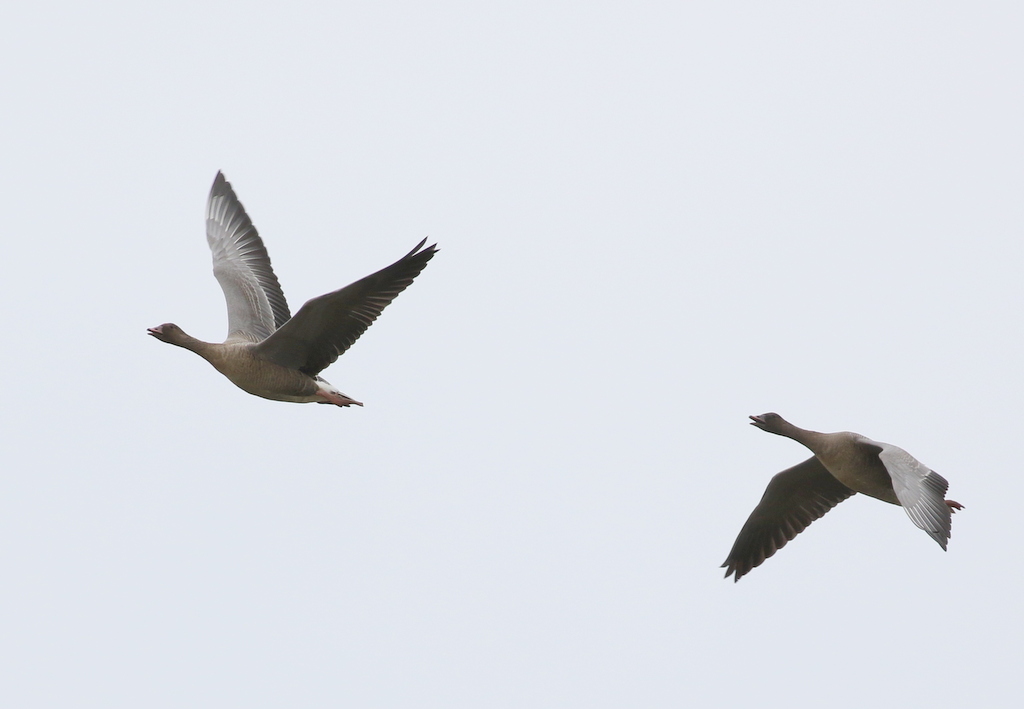
We made our way back to the car park – its was time to head for home. It had been a very enjoyable three days exploring some different parts of Norfolk, and we had seen a very good selection of birds and other wildlife.
















